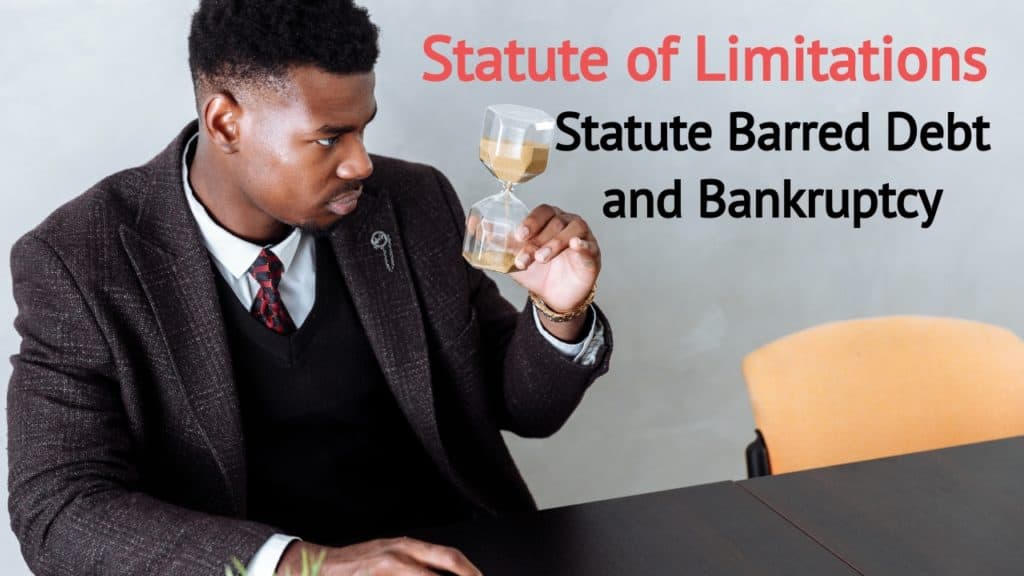
We hope that you and your family are safe, healthy and secure during this coronavirus pandemic.
Ira Smith Trustee & Receiver Inc. is absolutely operational and Ira, in addition to Brandon Smith, is readily available for a telephone consultation or video meeting.
If you would prefer to listen to the audio version of this Brandon Blog, please scroll to the very bottom and click play on the podcast.
Know Your Limitations: The Basic Limitation Period in Ontario
The basic limitation period in Ontario is 2 years from the date knowledge of the claim arises. The phrase “statute of limitations” is used to describe this time period. This is the time period between when you discover you have a claim and when you are legally permitted to bring that claim forward in a court of law. If you do not file your lawsuit within the 2-year limitation period, your right to sue will be extinguished and your claim will be forever lost. This is known as your claim being statute barred.
Statute of limitations: Limitations Act, 2002, S.O. 2002, c. 24, Sched. B
Each province has its very own rules, but the policies are comparable throughout the nation. In Ontario, the period is set by the Limitations Act, 2002, S.O. 2002, c. 24, Sched. B (Act). The Act sets out a time limit as to when legal proceedings might be commenced by suing. It defines the time in which an aggrieved person can start a claim developing from any type of injury, loss, or damage that happened as a result of an act or an omission.
The Act sets out the two-year limitation period as follows:
“Basic limitation period
4 Unless this Act provides otherwise, a proceeding shall not be commenced in respect of a claim after the second anniversary of the day on which the claim was discovered. 2002, c. 24, Sched. B, s. 4″
This is where the 2-year statute barred period of time is set in Ontario limitations law.
Can Your Debt Be Eliminated by the Statute of Limitations in Ontario?
Most people don’t realize that their debts can expire, just like the milk at the back of your fridge. In fact, while you can’t get rid of your debt by throwing it in the garbage, it can be eliminated by the basic statute of limitations under the Act. Debt is not considered timeless in Ontario.
There are two other main concepts under the Act also, which are not part of the discussion in this statute of limitations Brandon Blog. The two other main concepts are:
- Ultimate limitation period (Section 15 of the Act).
- The different proceedings in respect of for which limitation periods do not apply and therefore there are no time periods or time limits to worry about (Section 16 of the Act).
To keep it simple, when it comes to unsecured debt, the proceeding in respect of trying to recover on a debt by initiating legal action, and the focus of this blog, the applicable limitation period is the 2 year time statute of limitations period.

Statute of Limitations: How long can a debt collector pursue an old debt in Ontario
Last week I wrote a blog on various experts predicting that as the economy reopens, there will be increased activity by collection agencies and debt collectors. In that blog, I discuss the role of the debt collection agency and that they are all governed by provincial law. I also highlighted that they get their work either by trying to collect on the debts of their clients or they purchase accounts in default for less than the total amount owed and then try to collect as principal. Outstanding credit card debt is fertile ground for debt collectors and the debt collection process.
What do you do when a debt collector is pursuing you for an old debt? If it’s one you know you can’t pay, your first step should be to contact the agency and inform them of your situation. It’s important, to be honest, and precise when you tell them why you can’t pay what you owe.
Debt can be a very scary thing. When you owe money, you can feel like your life is one big bill you need to pay. It’s easy to want to hide from your creditors, but the more you avoid them, the more likely they will be to take drastic measures to collect their money. If you find yourself in such a situation, the best thing you can do is to face the music and get the matter settled. If you are in Ontario and have questions about your debt, or how to get it resolved, you can contact a Licensed Insolvency Trustee.
Statute of limitations: What does Ontario limitations law say about making a claim on debts even if I can’t sue?
In Ontario, there used to be substantial support for the interpretation that the right to be paid is not extinguished by the Act, but only the remedy of starting legal action in respect of the debt was eliminated. Various other provinces in Canada have passed provisions in their legislation that expressly states that upon the expiration of a limitation period, civil liberties are extinguished.
However, Ontario has not. In Ontario, the old way of thinking was that a financial obligation is snuffed out if an action on the financial debt is not brought within two years of its being due. Instead, the financial obligation continues to be owed.
There was even Ontario judicial authority for this position in:
- Re Bankruptcy of Kenneth Temple, 2012 ONSC 376 (CanLII) (the Temple case)
- Duca v. 2203824 Ontario Inc., 2020 ONSC 3119 (CanLII) (the Duca case)
But that is now in doubt given the recent decision of Master J. E. Mills (as she then was) who is now Justice J.E. Mills (the Registrar in Bankruptcy). Her decision released on March 8, 2021, In re: John Trevor Eyton, 2021 ONSC 1719 (CanLII), may have changed that. I say may, because the Temple and Duca cases were decided by a judge in the Ontario Superior Court of Justice. The Registrar in Bankruptcy sits below the Justices. However, she distinguished the Eyton case before her from the above two judicial decisions.
As you will read below, that decision may very well lead to a great statute of limitations period in respect of defence against any debts that a debt collector is trying to recover on, either by themselves or through legal action, where the debt went into default 2 years or more before.
Statute of limitations: Time limits, collections and bankruptcy
So what is the Eyton bankruptcy decision all about? The issue was a creditor appealing the Trustee’s decision disallowing the creditor’s proof of claim pursuant to s. 135(4) of the Bankruptcy and Insolvency Act (Canada) (BIA) (Form 77—Notice of Disallowance of Claim). The basis of the disallowance was that the Trustee took the position that the claim was statute barred.
The claim was for an unsecured loan where the last payment made was more than 2 years before the date of bankruptcy. Although there may have been some security agreement entered into, it was not perfected under Ontario law at the time of the bankruptcy. Therefore, there was no valid and enforceable security agreement in place.
The Trustee decided that the creditor, being a reasonable person, would have known about the default on the unsecured loan when the next scheduled payment was missed. That was more than 2 years before the bankruptcy and they did not take any action, including legal action. The Trustee went on to say that if the claim in respect of this unsecured loan could no longer be made, then the debt no longer exists.

Limitations analysis by the Court
It was indisputable by the creditor that the financial obligation owed by the bankrupt person was statute-barred under the Act and was not enforceable by way of legal action. The creditor relied upon the Temple and Duca cases listed above. They said that it stood for the proposition that although there was finality in respect of the fact that the creditor could not sue in court, the liability in respect of this unsecured debt remained.
The Trustee countered with a long background of case law which has held that in order to be a provable claim in bankruptcy, the financial obligation must be recoverable by legal process. If the financial obligation is statute-barred at the date of bankruptcy, the proof of claim is not sustainable. This principle was adopted by the Privy Council in 1943, the Alberta Court of Appeal in 1988 and the Court of Appeal for Ontario in 1996.
The court considered both lines of cases and decided that the cases cited by the Trustee, especially the 1996 Ontario Court of Appeal decision, bound the Registrar in Bankruptcy. She decided that the Temple and Duca cases could be distinguished and did not bind her decision.
Therefore, the creditor’s appeal was dismissed and the Trustee’s decision that if you can’t sue the debt is no longer a valid one was the correct interpretation.
What the Eyton statute of limitations analysis by the Court means for bankruptcy proceedings
There are some crazy results flowing from this Eyton decision which I am sure will result in more court decisions down the road.
First, the Registrar in Bankruptcy’s decision was in line with the Ontario Court of Appeal, but not certain judges’ decisions as decided in the Temple and Duca cases. The Temple and Duca cases were decided in a court lower than the Court of Appeal for Ontario but higher than the court in which the Registrar in Bankruptcy sits. So until a judge adopts her reasoning that the Temple and Duca cases are distinguishable, the first crazy result is that you have the various levels of the Ontario court system misaligned on this issue.
As a result of this decision in Eyton, we now have a second anomaly. In Temple, one of the judge’s findings was that a debt that is statute barred because of the statute of limitations can be used as the basis for qualification to launch a Bankruptcy Application against a debtor.
The Registrar in Bankruptcy noted that the line of cases relied upon by the Trustee in Eyton was not put before Justice Newbould (as he then was) when he heard Temple. Justice Newbould found in Temple that there was no Canadian authority for the suggestion that a statute barred debt could not support an application for a Bankruptcy Order.
The Registrar in Bankruptcy said that declaration was appropriate in the Temple case. As a result of these decisions, the legislation as it presently stands in Ontario is that a debt that is statute barred due to the statute of limitations, can be used in support of a Bankruptcy Application but after that could not constitute a provable claim in that same bankruptcy. This of course makes no sense.
Statute of limitations for unsecured debts and bankruptcy – What next?
My understanding is that the Eyton decision is being appealed. The appeal must be heard by a judge. Whatever the outcome of the appeal is, it will hopefully do away with these anomalies that currently exist.
UPDATE: THE APPEAL DECISION HAS BEEN RELEASED. TO READ OUR DISCUSSION ABOUT THE APPEAL RESULT, CLICK HERE.
The things to further consider are:
- Has the debtor given written confirmation of the existence and enforceability of the debt prior to the expiration of the limitation period and before the date of bankruptcy? If yes, then it is a valid debt and is a provable claim in bankruptcy.
- The disclosure of a statute barred financial obligation in the sworn Statement of Affairs by the insolvent debtor does not make up a recognition of the debt or the waiver of any limitation period for Limitations Act purposes.
- In respect of claims, the debtor is unsure of and the debtor has not given the written confirmation identified above, then the best treatment would be to include the creditor on the Statement of Affairs but as a contingent creditor. This will give that creditor notice of the bankruptcy and they can decide whether or not to file a proof of claim with backup. If filed, the Trustee will then review the claim and make a determination as to its validity and amount.

statute of limitations
Statute of limitations summary
I hope that you found this statute of limitations Brandon Blog interesting. If you are concerned because you or your business are dealing with substantial debt challenges and you assume bankruptcy is your only option, call me. It is not your fault that you remain in this way. You have actually been only shown the old ways to try to deal with financial issues. These old ways do not work anymore.
The Ira Smith Team utilizes new modern-day ways to get you out of your debt difficulties while avoiding bankruptcy. We can get you the relief you need and so deserve.
The tension put upon you is big. We know your discomfort factors. We will check out your entire situation and design a new approach that is as unique as you and your problems; financial and emotional. We will take the weight off of your shoulders and blow away the dark cloud hanging over you. We will design a debt settlement strategy for you. We know that we can help you now.
We understand that people and businesses facing financial issues need a realistic lifeline. There is no “one solution fits all” method with the Ira Smith Team. Not everyone has to file bankruptcy in Canada. The majority of our clients never do. We help many people and companies stay clear of bankruptcy.
That is why we can establish a new restructuring procedure for paying down debt that will be built just for you. It will be as one-of-a-kind as the economic issues and discomfort you are encountering. If any one of these seems familiar to you and you are serious about getting the solution you need, contact the Ira Smith Trustee & Receiver Inc. group today.
Call us now for a no-cost consultation.
We hope that you and your family are safe, healthy and secure during this coronavirus pandemic.
Ira Smith Trustee & Receiver Inc. is absolutely operational and Ira, in addition to Brandon Smith, is readily available for a telephone consultation or video meeting.

